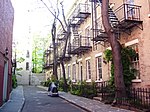The New York Women's House of Detention was a women's prison in Manhattan, New York City which existed from 1932 to 1974.
Built on the site of the Jefferson Market Prison that had succeeded the Jefferson Market in Manhattan's Greenwich Village, the New York Women's House of Detention is believed to have been the world's only art deco prison. It was designed by Sloan & Robertson in 1931 at a cost of $2,000,000 and opened to the public by Richard C. Patterson, Jr. on March 29, 1932. It did not receive its first inmates until some time later. Its location at 10 Greenwich Avenue gave the women inmates an opportunity to try to communicate with people walking by. After the prison was officially closed on June 13, 1971, Mayor Lindsay began the demolition of the prison in 1973, and it was completed the following year. It was replaced with a garden.Ruth E. Collins was the first superintendent at the prison. She embraced the design of the prison, labeling it "a new era in penology". Her mission was to effect the moral and social rehabilitation of the women in her charge, giving them a chance for "restoration as well as for punishment". She commissioned a number of art works as part of her mission to uplift the women and treat them all as individuals. Among the Women's House of Detention's most famous inmates were:
Polly Adler
Jane Alpert
Angela Davis
Dorothy Day
Andrea Dworkin
Miriam Moskowitz
Ethel Rosenberg
Afeni ShakurIn its later years, allegations of racial discrimination, abuse and mistreatment dogged the prison. Angela Davis has been outspoken about the treatment she witnessed. Andrea Dworkin's testimony of her assault by two of the prison's doctors led to its eventual closing. Audre Lorde described the House of Detention as, "a defiant pocket of female resistance, ever-present as a reminder of possibility, as well as punishment."In 2022, the historian Hugh Ryan published a history of the prison called The Women's House of Detention: A Queer History of a Forgotten Prison. He writes, "It was one of the Village's most famous landmarks: a meeting place for locals and a must-see site for adventurous tourists. And for tens of thousands of arrested women and transmasculine people from every corner of the city, the House of D was a nexus, drawing the threads of their lives together in its dark and fearsome cells."







